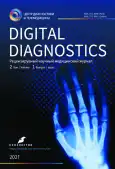Мнение студентов магистратуры о дистанционном обучении по специальности «Интервенционная радиология» с помощью электронных технологий: опрос учащихся
- Авторы: Neri E.1, Crocetti L.2, Lorenzoni G.2, Cioni R.2, Brady A.3, Caramella D.4
-
Учреждения:
- Пизанский университет
- Pisa University Hospital
- Mercy University Hospital, Cork & University College
- University of Pisa
- Выпуск: Том 2, № 1 (2021)
- Страницы: 17-26
- Раздел: Оригинальные исследования
- URL: https://journals.rcsi.science/DD/article/view/53701
- DOI: https://doi.org/10.17816/DD53701
- ID: 53701
Цитировать
Аннотация
Обоснование. Программа магистратуры «Интервенционная радиология» — первый учебный курс смешанного типа, предложенный нашим университетом по данному направлению. Программа включает практические занятия, очные лекции в отделении «Интервенционная радиология» в сочетании с онлайн-обучением.
Цель ― оценить мнение студентов о дистанционном обучении по программе магистратуры «Интервенционная радиология» (ИР) с помощью электронных технологий.
Методы. Основная учебная программа включает в себя 3 модуля дистанционного обучения и 2 смешанных модуля (дистанционное обучение + практические занятия). Электронное обучение осуществляется через специальную платформу для синхронного проведения практических и теоретических занятий в форме вебинаров и онлайн-лекций, которые записываются и загружаются на специальный веб-сайт для прямой трансляции. Практическое обучение проводится в лечебном учреждении, что позволяет студентам проводить интервенционные процедуры непосредственно с пациентами. Для оценки качества обучения подготовлен онлайн-опрос из 12 пунктов. Студенты оценивали степень согласия с предложенными утверждениями об эффективности электронного и практического обучения по пятибалльной шкале. По полученным ответам рассчитывали средний балл.
Результаты. В опросе принимали участие 16 человек: часть из них работает в государственных (неакадемических) лечебных учреждениях (62,5%), большинство участников на момент проведения опроса выполнили более 300 интервенционных процедур в качестве ведущих операторов (80%). Участники согласились с тем, что основные преимущества электронного модуля обучения ― возможность удалённого прослушивания лекций (68,8%) и относительная дешевизна обучения (18,8%). Все студенты оценили указанные преимущества не менее чем в 3 балла. В целом программа оправдала ожидания студентов в 81,3% случаев, что позволяет говорить об эффективности предложенной формы обучения.
Заключение. Участники остались довольны и выразили готовность рекомендовать учебный курс своим коллегам. Смешанная форма обучения получила высокую оценку и, как ожидается, станет полезной моделью изучения интервенционной радиологии.
Ключевые слова
Полный текст
Открыть статью на сайте журналаОб авторах
Emanuele Neri
Пизанский университет
Автор, ответственный за переписку.
Email: emanuele.neri@med.unipi.it
ORCID iD: 0000-0001-7950-4559
https://people.unipi.it/emanuele_neri/
Доцент, д.м.н. Отдел трансляционных исследований
Италия, ПизаLaura Crocetti
Pisa University Hospital
Email: laura.crocetti@med.unipi.it
ORCID iD: 0000-0002-8160-0483
MD, Associate professor
Италия, ПизаGiulia Lorenzoni
Pisa University Hospital
Email: giulia.lorenzoni@unipd.it
ORCID iD: 0000-0003-1771-4686
PhD Student
Италия, ПизаRoberto Cioni
Pisa University Hospital
Email: c.cioni@ao-pisa.toscana.it
ORCID iD: 0000-0001-9425-0286
Италия, Пиза
Adrian Brady
Mercy University Hospital, Cork & University College
Email: adrianbrady@me.com
ORCID iD: 0000-0003-3473-0282
MD, Clinical Senior Lecturer
Ирландия, КоркDavide Caramella
University of Pisa
Email: davide.caramella@unipi.it
ORCID iD: 0000-0002-9951-2916
MD, Professor
Италия, ПизаСписок литературы
- Union Européenne des Médecins Spécialistes. Medical Specialties. UEMS; 2009. Accessed 24 Jan 2017.Available from: https://www.uems.eu/about-us/medical-specialties.
- Mahnken A.H., Bücker A., Hohl C., Berlis A. White Paper: curriculum in interventional radiology // Fortschr Rontgenstr. 2017. Vol. 189, N 4. P. 309–311. doi: 10.1055/s-0043-104773
- Tsetis D., Uberoi R., Fanelli F., et al. The Provision of Interventional Radiology Services in Europe: CIRSE Recommendations // Cardiovasc Intervent Radiol. 2016. Vol. 39, N 4. P. 500–506. doi: 10.1007/s00270-016-1299-0
- Lee M.J., Belli A.M., Brountzos E., et al. Specialty status for interventional radiology: the time is now // Cardiovasc Intervent Radiol. 2014. Vol. 37, N 4. P. 862. doi: 10.1007/s00270-014-0903-4
- Siragusa D.A., Cardella J.F., Hieb R.A., et al. Requirements for Training in Interventional Radiology // J Vasc Interv Radiol. 2013. Vol. 24, N 11. P. 1609–1612. doi: 10.1016/j.jvir.2013.08.002
- Xiberta P., Boada I. A new e-learning platform for radiology education (RadEd) // Comput Methods Programs Biomed. 2016. Vol. 126. P. 63–75. doi: 10.1016/j.cmpb.2015.12.022
- Pinto A., Brunese L., Pinto F., et al. E-learning and education in radiology // Eur J Radiol. 2011. Vol. 78, N 3. P. 368–371. doi: 10.1016/j.ejrad.2010.12.029
- Rösch J. Tele-education in Interventional Radiology // CardioVascular and Interventional Radiology. 2001. Vol. 24, N 5. P. 295–296. doi: 10.1007/s00270-001-0020-z
- U.S. Department of Education. Evaluation of Evidence-Based Practices in online learning: a meta-analysis and review of online learning studies. U.S. Department of Education, Washington DC; 2010. Accessed 3 Jan 2017. Available from: https://www2.ed.gov/rschstat/eval/tech/evidence-based-practices/finalreport.pdf
- Sparacia G., Cannizzaro F., D’Alessandro D.M., et al. Initial experiences in radiology e-learning // Radiographics. 2007. Vol. 27, N 2. P. 573–581. doi: 10.1148/rg.272065077
- Ruiz J.G., Mintzer M.J., Leipzig R.M. The impact of e-learning in medical education // Acad Med. 2006. Vol. 81, N 3. P. 207–212. doi: 10.1097/00001888-200603000-00002
- Cook D.A. Web-based learning: pros, cons and controversies // Clinical Medicine. 2007. Vol. 7, N 1. P. 37–42. doi: 10.7861/clinmedicine.7-1-37
- Nkenke E., Vairaktaris E., Bauersachs A., et al. Acceptance of technology-enhanced learning for a theoretical radiological science course: a randomized controlled trial // BMC Med Educ. 2012. Vol. 12. P. 18. doi: 10.1186/1472-6920-12-18
- Santos G.N., Leite A.F., Figueiredo P.T., et al. Effectiveness of e-learning in oral radiology education: a systematic review // J Dent EDuc. 2016. Vol. 80, N 9. P. 1126–1139.
- Ellaway R. E-learning: Is the revolution over? Medical Teacher. 2011. Vol. 33, N 4. P. 297–302. doi: 10.3109/0142159X.2011.550968
Дополнительные файлы









